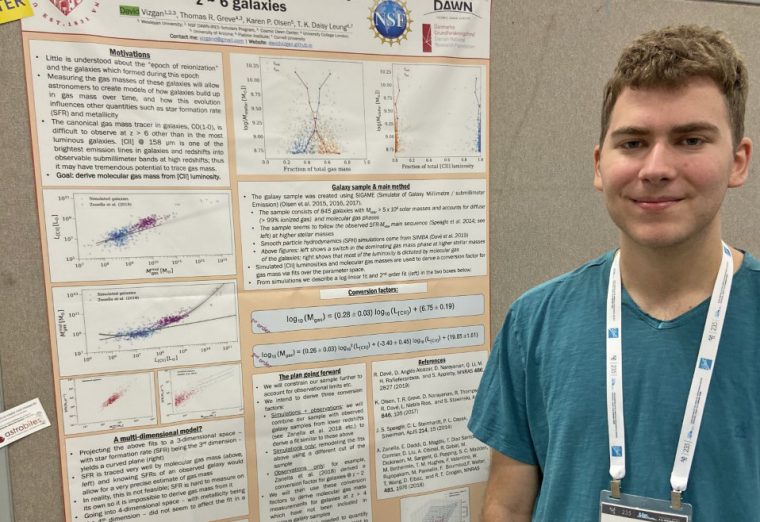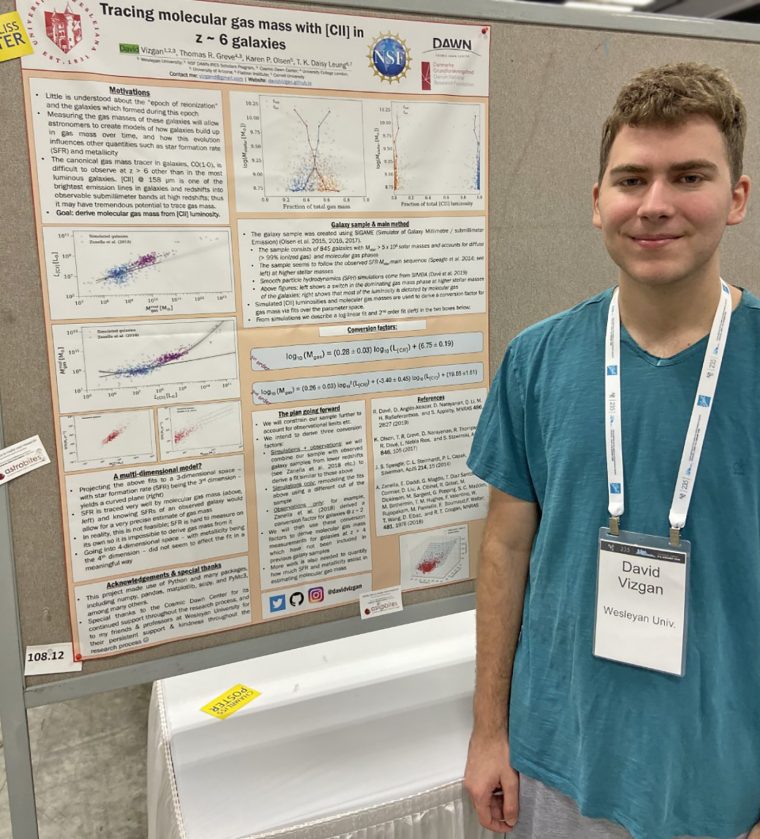Vizgan ’21 Honored with Chambliss Medal by American Astronomical Society


Astronomy and Physics major David Vizgan ’21 has expanded his interest of astrophysics to the far corners of the universe.
By using emissions of a “forbidden” line of ionized carbon [CII] in simulated galaxies, he’s trying to measure mass and other physical properties of young galaxies over 12.7 billion light years away which populated the universe shortly after the universe’s “dark ages”.
For his outstanding research poster presentation on the subject at the most recent American Astronomical Society meeting, David Vizgan ’21 received a Chambliss Astronomy Achievement Student Award.
Vizgan is one of 15 undergraduates students (out of 355 total entrants) to be honored with a Chambliss medal or certificate. The poster presentations were made during the 235th AAS meeting in Honolulu, Hawaii, Jan. 4–8.
At the meeting, Vizgan presented the research he began in summer 2019 at the Cosmic Dawn Center (DAWN) in Copenhagen as part of a NSF Research Experience for Undergraduates. He’s continued this study since returning last August.
Vizgan also is interested in determining the evolution of galaxies from looking at them at different redshift, or distance away from us measured by wavelengths. Galaxies at high-redshift are some of the youngest objects in the universe.
“Imagine you’re given two weeks in a forest to study the evolution of trees. What would you do? Well you’d probably want to look at trees—old trees, young trees, dead trees, trees that seem completely different from the others—and try to piece together the life story of a tree that way, and how it evolves over time,” Vizgan said. “Keep in mind now that, relative to the age of the universe, we’ve been around for a lot less than two weeks! In this universe, galaxies are the trees, and if we want to understand how these objects evolve with time, all we can really do is look at them in different stages of their lives.”
“Understanding galaxies in their youth could help us understand galaxies in all other stages of their lifetime as well as their role in the evolution of the universe,” he said.
Since returning from Copenahagen, Vizgan has been working with Associate Professor of Astronomy Meredith Hughes’ research group on modelling the debris disk around AU Microscopii, a small, “young” star dating only 12 million years old. (The sun, by comparison, is 4.6 billion years old). As concluded in a paper previously written by Cail Daley ’18, AU Mic’s debris disk was being stirred up by some large planetesimals—or maybe even an Earth-sized planet.
They’re measuring properties of this disk in a different wavelength using the ALMA radio telescope in Atacama, Chile.
“If we can verify Cail’s results with different observational data then we might be able to start analyzing what that ‘perturber’ might be,” said Vizgan, who hopes to turn these results into a thesis or published paper.
He’s hoping to accomplish this study over the summer.
“From my perspective, David has been engaged in research since his freshman year and has always shown a strong drive to gain new skills and put them to work to understand the universe around him,” Hughes said. “He has seized every opportunity, worked hard, and has been a colorful and integral member of our department community since he arrived on campus. I couldn’t be more proud of him.”
The Chambliss Astronomy Achievement Student Awards are named for longtime AAS member Carlson R. Chambliss, who taught at Kutztown University in Pennsylvania from 1970 to 2003. Dr. Chambliss not only donated the funds to mint the medals, but also designed them himself.
Vizgan plans to share the Chambliss medal with Wesleyan’s entire Department of Astronomy. He credits Hughes’ ASTR 155: Introductory Astronomy course for introducing him to his passion for astrophysics.
“I really could not have gotten this far in my studies without the undying support from my friends and professors at Wesleyan,” he said. “And I also would like to say that Professor Hughes is probably the greatest educator I’ve ever had in my life. She is a kind and thoughtful mentor who is teaching me how to do effective and efficient research, how to be a better scientist, and otherwise has been such a pillar of support for me throughout my time at Wesleyan.”
After graduating from Wesleyan, Vizgan plans to “expand [his] understanding of the universe” and pursue a PhD in astrophysics.
“I want to continue doing the kind of research that I’ve enjoyed so much over the last two years,” he said.

